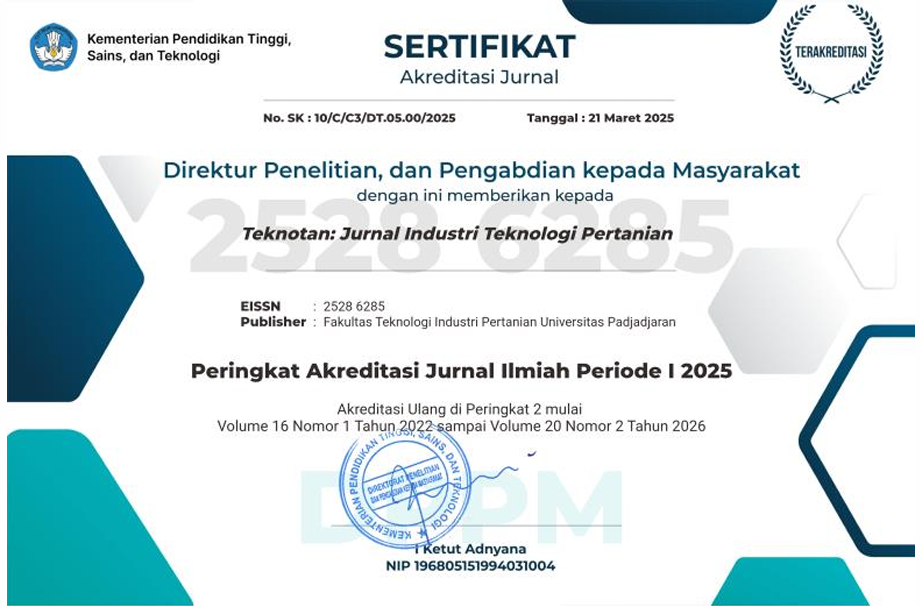Uji Kinerja dan Penerapan Nanobubble Generator pada Hidroponik Nutrient Film Technique (NFT) Terhadap Pertumbuhan Selada
Abstract
Nanobubble generator merupakan salah satu alat untuk menghasilkan gelembung halus dengan diameter < 1 µm. Nanobubble generator terdiri dari pompa dan nozel yang diaplikasikan pada larutan nutrisi sehingga kadar Dissolved Oxygen (DO) dapat meningkat. Hidroponik Nutrient Film Technique (NFT) memiliki kadar DO terkecil pada siang hari yaitu 5,2 mg/L. Kadar DO tersebut masih termasuk dalam kebutuhan tanaman hidroponik namun belum mendekati batas maksimal yaitu 8 mg/L. Penelitian ini bertujuan untuk mengetahui kinerja dan pengaruh nanobubble generator terhadap pertumbuhan selada pada hidroponik NFT. Uji kinerja nanobubble generator dilakukan dengan uji PSA, uji zeta potensial, pengukuran listrik, dan perubahan kadar DO. Pada penanaman selada terdapat 4 perlakuan meliputi; kontrol (P0), generate 3 hari sekali (P1), generate 7 hari sekali (P2), dan generate 10 hari sekali (P3). Penelitian menggunakan Rancangan Acak Kelompok (RAK). Hasil pengukuran tanaman dibandingkan dengan uji ANOVA, dan dilanjut dengan uji Duncan untuk mengetahui perbedaannya. Hasil uji kinerja nanobubble generator diantaranya diameter gelembung nano yaitu 394,6 nm; nilai indeks polidispersi (PDI) yaitu 1,783; zeta potensial sebesar -23,3 mV; daya, tegangan, dan arus listrik sebesar 98,47 Watt; 230,71 Volt; 0,44 Ampere. Hasil tersebut menunjukkan diameter gelembung sesuai standar ISO 20480-1-2017 dengan distribusi ukuran gelembung yang heterogen, serta memiliki stabilitas yang baik di dalam air. Hasil pengukuran biaya listrik sangat kecil yaitu Rp 426,1865 untuk satu masa panen. Hasil pengamatan pertumbuhan selada terdapat perbedaan kadar DO pada setiap perlakuan dengan penerapan nanobubble generator. Hasil panen pertumbuhan selada yang paling baik pada parameter berat segar, tinggi tanaman, dan lebar naungan yaitu dengan perlakuan P1 (generate setiap 3 hari sekali).
Full Text:
PDF (Bahasa Indonesia)References
Alam, H. S., Sutikno, P., Soelaiman, T. A. F., & Sugiarto, A. T. (2022). Bulk Nanobubbles: generation using a two-chamber swirling flow nozzle and long-term stability in water. Journal of Flow Chemistry, 1-13.
Dwiratna, S., Amaru, K., & Nanda, M. A. (2022). The Potential of Hydroponic Kit‐Based Growing on a Self‐Fertigation System for Pagoda Mustard (Brassica narinosa L) Production. The Scientific World Journal, 2022(1), 1984297.
Ebina, K., Shi, K., Hirao, M., Hashimoto, J., Kawato, Y., Kaneshiro, S., ... & Yoshikawa, H. (2013). Oxygen and air nanobubble water solution promote the growth of plants, fishes, and mice. PLoS One, 8(6), e65339.
Ikeura, H., Tsukada, K., & Tamaki, M. (2017). Effect of microbubbles in deep flow hydroponic culture on spinach growth. Journal of Plant Nutrition, 40(16), 2358-2364.
ISO 20480-1. 2017. Fine Bubble Technology – General Principles for Usage and Measurement of Fine Bubbles – part 1: Terminology, Geneva: International Organization for Standardization.
Kobayashi, N., & Yamaji, K. (2022). Leaf lettuce (Lactuca sativa L.‘L-121’) growth in hydroponics with different nutrient solutions used to generate ultrafine bubbles. Journal of Plant Nutrition, 45(6), 816-827.
Liu, S., Oshita, S., & Makino, Y. (2014). Stimulating effect of nanobubbles on the reactive oxygen species generation inside barley seeds as studied by the microscope spectrophotometer. In Proceedings. Int. Conf. of Agric. Eng., Zurich (pp. 06-10).
Liu, Y., Zhou, Y., Wang, T., Pan, J., Zhou, B., Muhammad, T., ... & Li, Y. (2019). Micro-nano bubble water oxygation: Synergistically improving irrigation water use efficiency, crop yield and quality. Journal of Cleaner Production, 222, 835-843.
Mahendra, H. I., Iswahyono, I., Djamila, S., Bahariawan, A., & Rizkiana, M. F. (2023). Evaluasi Kinerja Generator Microbubble Terhadap Kondisi Nutrisi dan Respon Pertumbuhan Kailan (Brassica Oleraceae) Secara Hidroponik Sistem DFT Di Dalam Greenhouse. JOFE: Journal of Food Engineering, 2(3), 154-162.
Meegoda, J. N., Aluthgun Hewage, S., & Batagoda, J. H. (2018). Stability of nanobubbles. Environmental Engineering Science, 35(11), 1216-1227.
Napsah, R. dan Wahyuningsih, I., (2014) Preparasi Nanopartikel Kitosan-Tpp Ekstrak Etanol Daging Buah Mahkota Dewa (Phaleriamacrocarpa scheff Boerl) dengan Metode Gelasi Ionik. Jurnal Farmasi Sains dan Komunitas (Journal of Pharmaceutical Sciences and Community), 11(1).
Nirmalkar, N., Pacek, A. W., & Barigou, M. (2018a). Interpreting the interfacial and colloidal stability of bulk nanobubbles. Soft matter, 14(47), 9643-9656.
Nirmalkar, N., Pacek, A. W., & Barigou, M. (2018b). On the existence and stability of bulk nanobubbles. Langmuir, 34(37), 10964-10973.
Park, J. S., Ohashi, K., Kurata, K., & Lee, J. W. (2010). Promotion of lettuce growth by application of microbubbles in nutrient solution using different rates of electrical conductivity and under periodic intermittent generation in a deep flow technique culture system. European Journal of Horticultural Science, 75(5), 198.
Phaengkieo, D., Chaoumead, A., Wangngon, B., & Chumnumwat, S. (2019). The application of nanobubble technology for DRFT hydroponics. Journal of Innovative Technology Research, 3(2), 33-41.
Qi, J., Wang, J., Gong, Z., & Zhou, J. M. (2017). Apoplastic ROS signaling in plant immunity. Current opinion in plant biology, 38, 92-100.
Sari, E., Kitty, Y., & Dwiranti, A. (2016). Sistem hidroponik Nutrient Film Technique (NFT) dan wick pada penanaman bayam merah. Surya Octagon Interdisciplinary Journal of Technology, 1(2), 223-225.
Sritiontip, C. (2022). Effects of micro-nano bubbles and electrical conductivity of nutrient solution on the growth and yield of green oak lettuce in a hydroponic production system. Journal of Science and Agricultural Technology, 3(1), 16-24.
Suhl, J., Oppedijk, B., Baganz, D., Kloas, W., Schmidt, U., & van Duijn, B. (2019). Oxygen consumption in recirculating nutrient film technique in aquaponics. Scientia Horticulturae, 255, 281-291.
Thichuto, S., Sritontip, P., Thonglek, V., & Sritontip, C. (2022). Effects of electrical conductivity and micro/nanobubbles in nutrient solutions of hydroponics on growth and yield of cherry tomato. Journal of Science and Agricultural Technology, 3(2), 29-36.
Ulatowski, K., Sobieszuk, P., Mróz, A., & Ciach, T. (2019). Stability of nanobubbles generated in water using porous membrane system. Chemical Engineering and Processing-Process Intensification, 136, 62-71.
Ushikubo, F. Y., Furukawa, T., Nakagawa, R., Enari, M., Makino, Y., Kawagoe, Y., ... & Oshita, S. (2010). Evidence of the existence and the stability of nano-bubbles in water. Colloids and Surfaces A: Physicochemical and Engineering Aspects, 361(1-3), 31-37.
Wang, S., Liu, Y., Lyu, T., Pan, G., & Li, P. (2020). Aquatic macrophytes in morphological and physiological responses to the nanobubble technology application for water restoration. ACS ES&T Water, 1(2), 376-387.
Wang, Y., Wang, S., Sun, J., Dai, H., Zhang, B., Xiang, W., ... & Zhang, W. (2021). Nanobubbles promote nutrient utilization and plant growth in rice by upregulating nutrient uptake genes and stimulating growth hormone production. Science of the Total Environment, 800, 149627.
Wu, Y., Lyu, T., Yue, B., Tonoli, E., Verderio, E. A., Ma, Y., & Pan, G. (2019). Enhancement of tomato plant growth and productivity in organic farming by agri-nanotechnology using nanobubble oxygation. Journal of agricultural and food chemistry, 67(39), 10823-10831.
Yusuf, A., Asdak, C., Muhaemin, M., NP, S. D., Sugiarto, A. T., & Alam, H. S. (2024). The Implementation of Micro/Nanobubbles (MNBs) Technology to Treat Basin Water as The Primary Water Source for Hydroponics in Greenhouse. Jurnal Teknik Pertanian Lampung (Journal of Agricultural Engineering), 13(1), 197-204.
DOI: https://doi.org/10.24198/jt.vol18n3.4
Refbacks
- There are currently no refbacks.
Indexed by:

This work is licensed under a Creative Commons Attribution 4.0 International License (CC BY-SA 4.0)


1.png)
.png)







